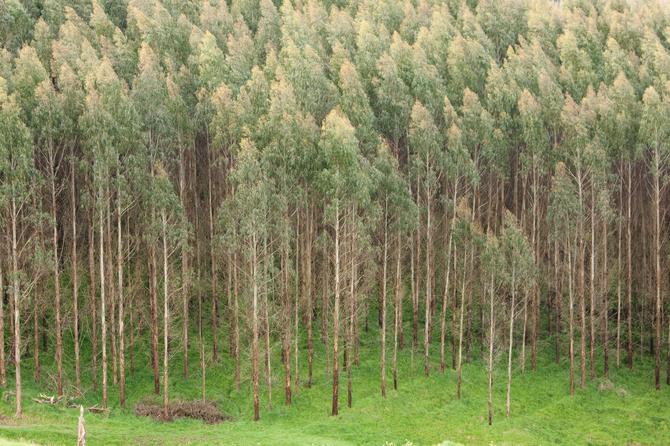Over the next few years, Australia will produce a hardwood supply like never before. Tasmania alone will produce a massive 3 million cubic metres of the material each year.
The result of mass plantings of blue gum and shining gum in the 1990s and early 2000s, this hardwood was initially grown to be chipped and made into paper products.
Now sustainable architecture researchers in Tasmania are showing that the hardwood could have many additional uses, including replacing structural concrete in high-rise buildings.
According to Professor Greg Nolan, Director of the University of Tasmania’s Centre for Sustainable Architecture with Wood (CSAW), one of the challenges in increasing the uptake of this structural plantation hardwood is in changing the building industry’s mindset.
“In the marketplace, people are used to pine or traditional native forest hardwood timber,” he says.
“Pine usually captures the structural market because it’s easy to work and economical for the stud frames commonly used in housing, and the bulk of traditional hardwoods ends up in appearance products, because of their visual appeal.”
“But this new plantation hardwood falls somewhere in between those things. It could be milled into single boards for structural applications, but pine will generally always be cheaper. As simple framing, structural plantation hardwood will struggle to complete.”
Nolan and his colleagues at CSAW have been investigating uses for plantation hardwoods in mass timber products such as cross-laminated timber (CLT) and glulam, where individual hardwood boards are glued together to provide enough strength and structural integrity to replace concrete on multi-storey buildings.
“Architects have a concept that timber is really only suitable for the structures of single- or two-storey buildings. But things like mass timber construction can do much more – if you want to go to 10 storeys, that’s no problem,” he explains.
“But as soon as you accept that you can do that, you need architects, engineers, and manufacturing skill that we haven’t needed before in Australia.”
Already, several prominent multi-storey buildings in Sydney, Melbourne, and Brisbane have been built using mass timber products, relying mainly on softwood timber and production expertise from America and Europe.
The University of Tasmania is now working with Australian building and timber industries to develop expertise in all aspects of using the new structural hardwood – from drying and processing through to coming up with applications that will appeal to customers.
The concrete alternative
Two decades ago, the Australian Government encouraged investment in plantation forests, which resulted in the establishment of several hardwood eucalypt plantations.
“The Government was aspiring to have three million hectares of plantations in the ground by 2020, and managed to get the national estate from about 1 million hectares to about two million hectares,” says Nolan.
The Global Financial Crisis (GFC) in 2007 and 2008 presented a major obstacle to further expansion of plantation forests, as many plantation companies fell into bankruptcy or were forced to sell their estates. Most plantations changed hands.
“Now new owners are seeking to understand what they’ve got, and how to make the most of the timber,” says Nolan.
“It’s a good time to be a researcher. There are millions of cubic metres of timber being produced, and there is a real economic imperative to recover a greater return from this material, both for the companies and for society in general. However, there are real technical challenges.”
“The trees in these plantations were selected and managed for paper production, not for hardwood building products. Also, they are harvested when they are only 18 to 20 years old, while most traditional hardwoods are harvested after 80 years or more in the ground. So, it really is a new, different material to be used in new, different products.”

One area the CSAW researchers have been focussed on is perfecting ways of drying the hardwoods.
“It’s quite easy to get water out of pine – usually it’s just four to five days in a kiln,” Nolan explains. “But with hardwood, I can’t do that. The cell structure is much, much more complex. I have to take the water out slowly.”
Using sensors around drying racks, CSAW researchers can measure everything from humidity to airflow, and work out the quickest way to dry the hardwoods.
Recent tests have shown that enhanced hardwood air-drying can improve the recovery of the material (in other words, the final quality of the material) by more than 10 to 20 percent, with a cost benefit of almost $12 million to the Tasmanian timber industry.
“This advanced drying is taking a traditional industry and mixing in advanced understanding of how drying works, as well as the latest computerised sensing and modelling technologies, to get the best result,” says Nolan.
He adds that one of the challenges in developing new hardwood building products is that the building design and construction industry is often reluctant to try new materials and methods.
“People in the building sector are terribly conservative, because the costs of building are so high and the impact of things going wrong is substantial.”
Yet Sydney-based property group Lendlease has now built several prominent multi-storey Australian buildings using mass timber construction, which could encourage more companies try it.
“Building structurally with timber is much faster, and much cleaner,” says Nolan. “Fewer people are required on site, and construction takes less time, and has much less impact on local communities.”
There’s also the environmental benefit, as 50 percent of the weight of the timber that’s used to construct a building is atmospheric carbon that the tree has absorbed, which means you’re locking it up for the life of the building.
In the coming years, if structural plantation hardwood can become as synonymous to building as concrete has been for so long, Australia will see major gains in the sector.
“In the future, if someone is building a six-storey complex, it might not be concrete trucks coming past all the time,” says Nolan. “It will be trucks loaded with large, solid timber panels.”
Key facts
- Australia currently produces about 10 million cubic metres of plantation hardwoods annually, and almost all of it is being exported. Adding value to this material is an enormous economic opportunity, especially in regional areas.
- Structural hardwood in mass timber products can replace concrete in buildings – even those of 10 or more storeys.
- Each cubic metre of concrete produced for the construction of a building results in the release of about 300 kg of greenhouse gas emissions. Each cubic metre of timber used in a building sequesters about 700 kg of greenhouse gas emissions. This makes using structural timber a more sustainable choice.
- 50% of the weight of timber used in construction is atmospheric carbon, which is locked away for the life of the building
Interested in conducting your own research? Apply now to become a research student.
Interested in partnering with the University of Tasmania? Find out more here.



